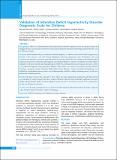Please use this identifier to cite or link to this item:
https://hdl.handle.net/20.500.14356/1537Full metadata record
| DC Field | Value | Language |
|---|---|---|
| dc.contributor.author | Devkota, Narmada | - |
| dc.contributor.author | Subba, Shishir | - |
| dc.contributor.author | Devkota, Janardan | - |
| dc.contributor.author | Regmee, Jaya | - |
| dc.contributor.author | Pokhrel, Deepika | - |
| dc.date.accessioned | 2023-05-15T10:22:24Z | - |
| dc.date.available | 2023-05-15T10:22:24Z | - |
| dc.date.issued | 2018 | - |
| dc.identifier.citation | DevkotaN., SubbaS., DevkotaJ., RegmeeJ., & PokhrelD. (2018). Validation of Attention Deficit Hyperactivity Disorder Diagnostic Scale for Children. Journal of Nepal Health Research Council, 16(3), 264-268. https://doi.org/10.33314/jnhrc.v16i3.1407 | en_US |
| dc.identifier.issn | Print ISSN: 1727-5482; Online ISSN: 1999-6217 | - |
| dc.identifier.uri | http://103.69.126.140:8080/handle/20.500.14356/1537 | - |
| dc.description | Original Article | en_US |
| dc.description.abstract | Abstract Background: There is no valid Attention Deficit Hyperactivity Disorder diagnostic tool to fit Nepalese culture and language till date. Current study is intended to develop and validate the Attention Deficit Hyperactivity Disorder scale for children in Nepal. Methods: Mixed method study was conducted with 840 samples (i.e. children with Attention Deficit Hyperactivity Disorder =356, Anxiety =128 and General Population=356).Items generation, scale development and scale evaluation were the three consecutive steps followed to develop and validate the scale.Children with Attention Deficit Hyperactivity Disorder (already met the Diagnostic and statistical Manual-5 criteria) were further assessed by Kiddie-Schedule for Affective disorders and Schizophrenia (K-SADS-PL), Child and Adolescent Symptoms Inventory (CASI-5) to confirm the diagnosis and psychometric validation. Pilot studies were done for items clarity. Each data obtained from three comparison groups (Attention Deficit Hyperactivity Disorder , Anxiety and General Population) were included for standardization process where tests of dimensionality, reliability, validity,calculating norms (cut off) were doneas scale evaluation process. Results: The final version of the scale had 21 items. Three sub-scales (Inattention, Impulsivity and Hyperactivity) were identified by using Principal Axis Factor Analysis.All factors showed strong statistically significant convergent validity and Discriminant validity Cronbach’s alpha of each item is ? 0.91.As total score criteria, 38.5 is considered as the best cut-off point for this scale. Conclusions: By using systematic process, a valid and reliable Attention Deficit Hyperactivity Disorder diagnostic scale is being developed in Nepalese culture and language. Keywords: ADHD; development and validation; executive function. | en_US |
| dc.language.iso | en | en_US |
| dc.publisher | Nepal Health Research Council | en_US |
| dc.relation.ispartofseries | Jul-Sep 2018;1407 | - |
| dc.subject | ADHD | en_US |
| dc.subject | Development and validation | en_US |
| dc.subject | Executive function | en_US |
| dc.title | Validation of Attention Deficit Hyperactivity Disorder Diagnostic Scale for Children | en_US |
| dc.type | Journal Article | en_US |
| local.journal.category | Original Article | - |
| Appears in Collections: | Vol. 16 No. 3 Issue 40 Jul - Sep 2018 | |
Files in This Item:
| File | Description | Size | Format | |
|---|---|---|---|---|
| 1407-Manuscript-6621-1-10-20181030.pdf | Fulltext Article. | 202 kB | Adobe PDF |  View/Open |
Items in DSpace are protected by copyright, with all rights reserved, unless otherwise indicated.
